A high percentage of goods are intended for carriage by combined road, rail, water and air transport, whether through repeated transshipment or intermodally using containers, swap-bodies or other transport units. Packaging, labeling, stowage and securing deficiencies can generally only be established during dispatch by spot checks. Since minor carelessness may cause serious losses, expert packing and securing are essential for loss-free carriage.
This handbook pays particular attention to negligence with regard to dispatch, which may result in losses and/or (could) form the basis of compensation payments. It has as its central theme issues relating to transport legislation, some of which will be explained and commented on in more detail. The fundamental rules to which reference will frequently be made are contained in
- CTU packing guidelines
Guidelines for the packing of cargoes, other than bulk cargoes, into or onto cargo transport units (CTUs) applicable to transport operations by all surface and water modes of transport
17th February 1999
The abbreviation CTU stands for "Cargo Transport Unit" and has the same meaning as the expression "Intermodal Transport Unit"/"ITU").
 |
Empty containers at a sea port |
The preamble of the CTU packing guidelines points out that the use of containers, swap-bodies, vehicles or other CTUs substantially reduces the physical hazards to which cargoes are exposed.
 |
Inadequately secured cargo on a flatrack, loaded on a roll trailer |
However, they also emphasize that improper or careless packing of cargoes into or onto CTUs or improper cargo securing may cause accidents with involving personal injury during handling or transport of CTUs.
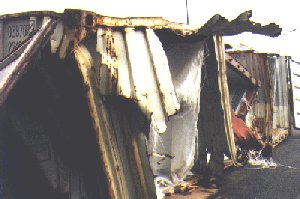 |
Damage caused to several containers by inadequate cargo securing |
It is also pointed out that considerable damage may additionally be caused to the cargo or CTU.
 |
Container packer adding the finishing touches |
It is also stressed that the person who packs and secures the cargo is often the last person able to look inside a CTU before it is opened by the receiver at its destination. The preamble actually states:
- drivers of road vehicles and other road users if the CTU is transported by road;
- railroad employees and others, if the CTU is carried by rail;
- crews of inland waterway vessels, if the CTU is carried on inland waterways;
- handling staff at inland terminals when the CTU is transferred from one means of transport to another;
- dock workers when the CTU is loaded and discharged;
- ships' crews, who often accompany the CTU under the most severe transport conditions;
- those who unpack the CTU.
If containers have been closed with seals and locked, it is impossible for road vehicle drivers to check how well they have been packed and secured. Even if the transport units are freely accessible, it would still only be possible, for the most part, to inspect the cargo in the door area of box containers.
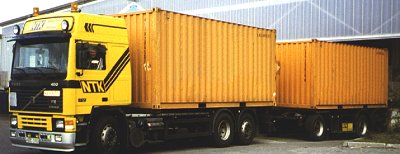 |
|
| Truck combination with (safely packed) hazardous materials containers |
Improperly packed containers could reduce the safety of road vehicles, e.g. due to weights shifting within the container, and encourage vehicles to overturn. Containers transported on trailers constitute a particular hazard if they are poorly packed and the cargo is inadequately secured.
Switchmen and other railroad employees are not responsible for checking that CTUs have been properly packed.
Their inspection duties may extend to the proper securing of CTUs on freight cars, but not to the situation inside locked CTUs. If deficiencies are detected in open CTUs, a responsible employee is sure to intervene.
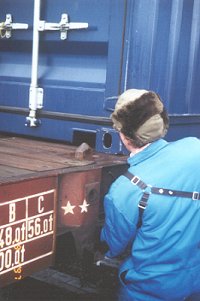 |
Rail vehicle with container during switching |
Poorly packed and inadequately secured cargoes may put not only the switchmen but also rail passengers and other innocent parties at risk.
 |
Unsecured cargoes can put people's lives at risk. |
Poorly secured cargoes have frequently been known to smash through the end walls of a CTU in the event of a switching impact or even through the side walls during carriage by rail.
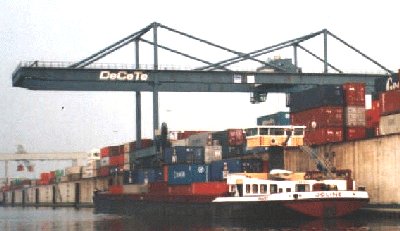 |
|
| Containers on an inland waterway vessel |
Naturally, the crews of inland waterway vessels cannot be expected to inspect the CTUs delivered to them for secure packing.
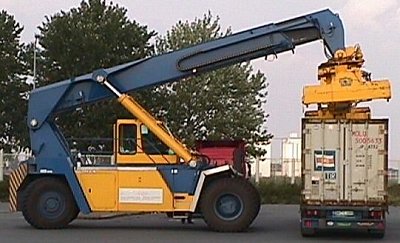 |
|
| Transfer of a container |
Cargo handling crews at inland terminals are put at risk by poorly packed, inadequately secured CTU cargoes, if they have to transfer them from one means of transport to another, as are dock workers when loading and discharging the CTU.
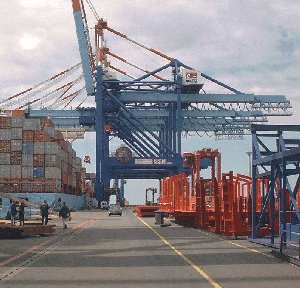 |
Loading and discharging operations at the sea port |
As far as marine transport is concerned, the ship's command does not have any possibility, on a day to day basis, of influencing how CTUs are packed or how cargoes are secured in them.
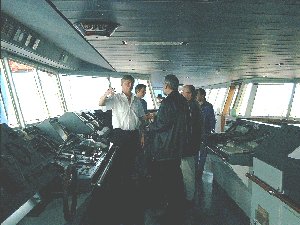 |
Captain of a container ship with visitors on the bridge |
In the early days of container shipping, it was common practice for the cargo officer to carry out at least occasional spot checks at the ports on the containers delivered for shipment. Today, due to high cargo volumes, short laytimes in port and reduced crewing levels, this is possible only very occasionally. The long-established practice of having containers checked and inspected by experts employed by the shipping companies or loss adjusters instructed by the carriers has also mostly been abandoned for cost reasons. These days, containers are only occasionally inspected by experts before loading onto the ship.
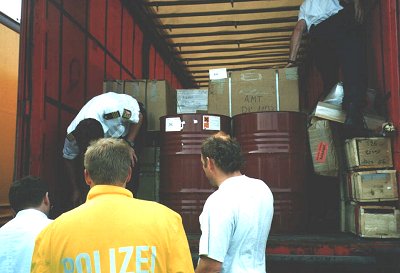 |
|
| Water police inspecting a trailer to be carried by ferry |
Occasionally, authorities such as the water police carry out spot checks on CTUs carrying hazardous materials.
The results of such inspections are shocking. Around 70% of containers, swap-bodies, semitrailers and other "cargo transport units" reveal clear deficiencies.
| From a legal standpoint, an inspection by the ship's command is unnecessary, since the people who pack a container are responsible for ensuring that all regulations are observed. In the case of containers carrying hazardous materials, such compliance must even be confirmed by a signature on the container packing certificate. Accordingly, in the case of FCL/FCL and FCL/LCL containers, the shipper is usually responsible. The bill of lading documents this in the "shipper's load, stowage and count" clause. In the case of LCL/FCL and LCL/LCL containers, those responsible are those instructed to pack. With regard to legal liability, they bear the consequences of any deficiencies or omissions, insofar as these are not caused by the customer, for example because the latter fails to pay for necessary work to be carried out or for securing or has only very specifically defined work carried out. If people or the environment are harmed by deficient container packing, those responsible may be prosecuted. The potential for risk is particularly great when packing hazardous materials. |
Theoretically, it is only possible for the crew of a ship to inspect cargo securing where "open" CTUs are used, such as flatracks, platforms etc., and then only when the cargo is not additionally covered by tarpaulin or otherwise hidden from view.
Those who unpack a CTU are the last people in the transport chain who may be put at risk by packaging deficiencies, poor packing and inadequate cargo securing.
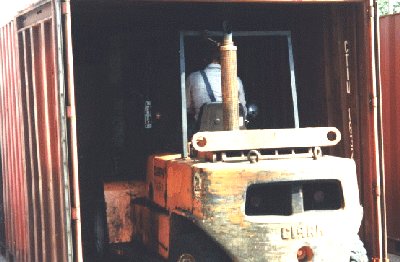 |
|
| Forklift truck driver stripping a container |
The CTU packing guidelines do not mention the danger to individuals who inspect CTUs in the course of their work, such as police, loss adjusters and cargo inspectors.
 |
Motorway police inspecting containers |
The container (picture to the right) is packed with hazardous materials. This should have been packed in the door area, but instead was "hidden" under other items of cargo and could not be found.
Without at this point going into individual paragraphs, articles or points of regulations, laws or guidelines, it should be noted that with this type of transport too it is the shipper's duty to ensure proper packing and securing.
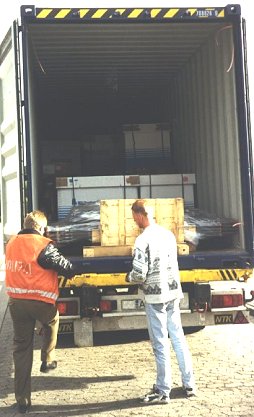 |
Poorly packed, inadequately secured container loads may also put innocent third-parties at risk if shifting items of cargo smash through the container walls or cause a vehicle carrying the container to overturn. | |
| Inadequately secured container load |
Normally, a CTU trucker cannot be held liable for losses arising due to improper packing of containers, swap-bodies, semitrailers etc., if the latter are closed with seals and are loaded in operationally safe manner, which is the case if the vehicle is roadworthy and working safely. A trucker's contract of carriage usually applies only to transport of the CTU. His duty to load the CTU in operationally safe manner is fulfilled if the appropriate total weights and axle loads are complied with, appropriate locking of the CTU is ensured and hitching is performed correctly.
If a vehicle is sealed, the trucker does not have any way of influencing, supervising or even checking packing and securing of the load. Losses due to such deficiencies, or even to packaging deficiencies, cannot therefore lie within his area of responsibility, but instead lie squarely with the shipper.
If truckers notice obvious deficiencies when they take delivery of CTUs or later due to the driving behavior of their vehicle, they must respond accordingly, however. It is advisable to ask the shipper for information or instructions.
In the case of unsealed vehicles, an internal visual inspection is advisable. Any gross errors may then be discovered. In practice such inspections are hardly ever performed, but this may make the driver partly responsible.
The shipper must always ensure that cargoes are loaded and secured in such a manner as to be safe for transport, as he is not only liable for damage to the cargo but also for damage to the vehicle or injury to third-parties resulting from dereliction of his duty.
The following is stated in § 22 of the German road traffic code, para. 1:
- (1) The load, together with clamping chains, gear and other loading equipment, must be stowed so as to be safe during transport and be secured especially so as to prevent it from falling off and from making avoidable noise.